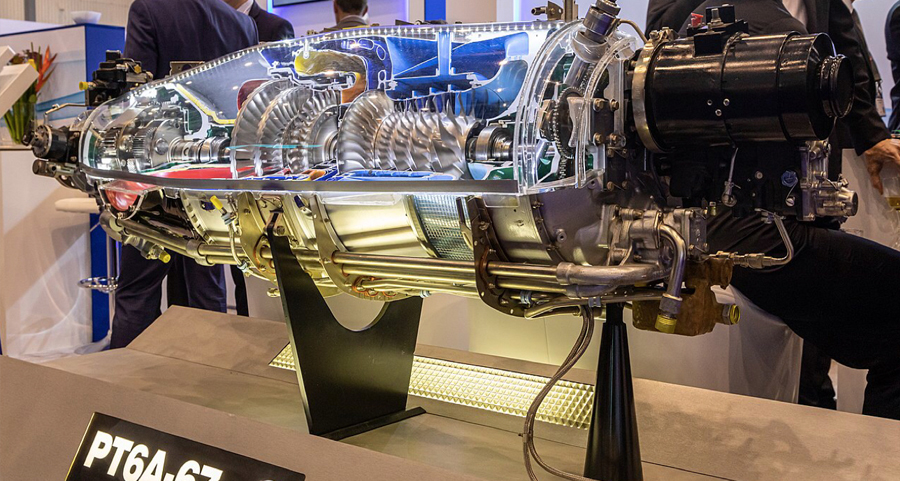
3 Things You Didn’t Know About the PT6A Engine
The PT6A Design Solved a Crucial Problem in Maintenance Procedures
Gas turbine engines are composed of hot-running parts and cool-running parts. Within current technology this physically cannot be avoided, and the result is an imbalance in part deterioration; the hottest parts need to be repaired and replaced more often than the coolest parts. Having to remove the entire engine from an aircraft and disassemble it in order to get to the hottest parts is a lengthy and expensive process. The achievement of the PT6A did away with the need to remove the entire engine by placing the hottest parts, the combustion chamber and gas generator turbine, at the propeller end of the aircraft. They can be removed without disrupting the rest of the engine and its connections. Chief Designer Allan Newland patented this arrangement; he was one of the original ‘Dirty Dozen’ who created the iconic turboprop. All adaptations of the engine consist of two basic sections that can be easily separated for maintenance and repairs.
Until the development of the Pratt & Whitney PT6A, most aircraft engine intakes were positioned at the front end of the vehicle. A PT6 installation is mounted with the intake toward the rear, making it known by many as the “back-to-front” engine. This ensures the power section is at the front of the nacelle, driving the propeller directly without the need for a long shaft. Two exhaust outlets are aimed astern, and intake air is fed to the engine through an underside mounted duct. This setup assists maintenance by permitting the power section to be removed, propeller and all, and exposing the gas generator section. There are a few special installations, such as the PT6A-66B in the Piaggio Avanti P180 where the engine is reversed, making the propeller act as a “pusher” with the accessory gearbox positioned toward the front.
The Engine is Used in More Than 100 Applications
The first flight of the PT6 was on May 30th, 1961, as a third engine in the nose of a Beech 18 aircraft. The Beech 18 was used as a PT6 and propeller test-bed until 1980, when it was swapped for a Beech King Air. The PT6 quickly gained recognition and it’s popularity skyrocketed in the aviation community. Since then, the original and variants have been used in more than 100 different applications, including the following:
- AASI Jetcruzer
- Aero Commander 680T (PT6 Conversion)
- Aero Ae 270 Ibis
- AHRLAC Holdings Ahrlac
- Air Tractor AT-400
- Air Tractor AT-501
- Air Tractor AT-602
- Air Tractor AT-802
- Antilles Super Goose
- Antonov An-28
- Ayres Turbo Thrush
- Basler BT-67
- Beechcraft 1900
- Beechcraft Model 99
- Beechcraft A36TC Bonanza (turbine conversion)
- Beechcraft C-12 Huron
- Beechcraft King Air
- Beechcraft Lightning
- Beech 18 Series (turbine conversion)
- Beechcraft Model 87
- Beechcraft RC-12 Guardrail
- Beechcraft RU-21C Ute
- Beechcraft Starship
- Beechcraft Super King Air
- Beechcraft T-6 Texan II
- Beechcraft T-34C Turbo-Mentor
- Beechcraft T-44 Pegasus
- Beriev Be-30K
- Calidus B-250
- CASA C-212 series 300P
- Cessna 208 Caravan
- Cessna P210N (turbine conversion)
- Cessna 404 Titan (turbine conversion)
- Cessna 421C Golden Eagle (turbine conversion)
- Cessna 425 Corsair/Conquest I
- Conair Turbo Firecat
- Conroy Tri-Turbo-Three
- De Havilland Canada DHC-2 Mk. III Turbo Beaver
- De Havilland Canada DHC-2T Turbo Beaver
- De Havilland Canada DHC-3 Otter (turbine conversions)
- De Havilland Canada DHC-6 Twin Otter
- De Havilland Canada Dash 7
- Dominion UV-23 Scout
- Dornier Do 128 Turbo Skyservant
- Dornier Seawings Seastar
- Douglas DC-3 (turbine conversions)
- Epic LT Dynasty
- Embraer EMB 110 Bandeirante
- Embraer EMB 121 Xingu
- Embraer EMB 312 Tucano
- Embraer EMB 314 Super Tucano
- Frakes Mohawk 298
- Frakes Turbocat
- Gulfstream American Hustler 400
- Grumman Mallard (turbine conversion)
- Grumman Goose (turbine conversion)
- Harbin Y-12
- Helio AU-24 Stallion
- IAI Arava
- IAI Eitan
- Indonesian Aerospace N-219
- JetPROP DLX
- Kestrel K-350
- KAI KT-1
- Let L-410 Turbolet
- Lancair Evolution
- NAL Saras
- NDN Fieldmaster
- FTS Turbo Firecracker
- PAC 750XL
- PAC Cresco
- Piaggio P.180 Avanti
- Pilatus PC-6/B Turbo-Porter
- Pilatus PC-7
- Pilatus PC-9
- Pilatus PC-12
- Pilatus PC-21
- Piper PA-31P (turbine conversion)
- Piper PA-31T Cheyenne
- Piper PA-42 Cheyenne III
- Piper PA-46-500TP Meridian
- Piper T1040
- PZL-130T Turbo Orlik and PZL-130TC-II Orlik
- PZL M-18 Dromader (turbine conversion)
- PZL M28 Skytruck
- Quest Kodiak
- Reims-Cessna F406 Caravan II
- Saunders ST-27/ST-28
- Scaled Composites ATTT
- Shorts 330
- Shorts 360
- Short C-23 Sherpa
- Socata TBM
- Spectrum SA-550
- Swearingen SA26-T Merlin IIA
- US Aircraft A-67 Dragon
- TAI Hürkus
- Baykar Bayraktar Akinci-B
It Was Almost Cancelled
In 1956, engineering manager Dick Guthrie was directed by Pratt & Whitney Canada’s president, Ronald Riley, to hire a team of gas turbine experts to develop a small gas turbine engine. The Wasp radial engine was still in demand but the goal was to become Canada’s ultimate engine company by targeting a small gas turbine engine. Twelve engineers were recruited by Guthrie and the team carefully studied market assessments to determine their next engine. Their sights were set on developing a 450 shaft horsepower turboprop for twin-engined aircraft: The PT6. However, early development of the PT6 was riddled with problems. Engineering issues, lack of sales, and excessive costs almost resulted in total cancellation of the project. As one team member recalled, they lacked the ability to overcome technical difficulties because they came from design and research backgrounds. But the team, and those in charge, had a vision and were determined to make it work. Instead of cancelling the project, they shifted their focus to learning how to run a development program and intensified their efforts, such as implementing around-the-clock testing. The first production model, the PT6A-6, was certificated in 1963, with it’s first application being the Beech Queen Air.
Since then, it has become Pratt & Whitney’s biggest success story with over 50 variants of the PT6A having been produced and delivered all over the world. As the most popular free-turbine turboprop engine on Earth, the PT6A is a perfect example of how a hardworking team with dedicated focus can overcome adversity, even on the brink of failure, and produce an absolutely legendary product.
Sources:
Pratt & Whitney - https://prattwhitney.com/
Wikipedia - https://en.wikipedia.org/wiki/Pratt_%2526_Whitney_Canada_PT6#
